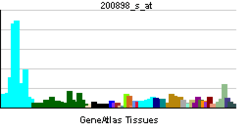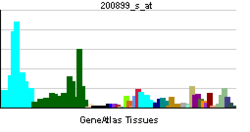MGEA5
Bifunctional protein NCOAT is a protein that in humans is encoded by the MGEA5 gene.[3][4][5]
References
Further reading
- Nakajima D, Okazaki N, Yamakawa H, et al. (2003). "Construction of expression-ready cDNA clones for KIAA genes: manual curation of 330 KIAA cDNA clones". DNA Res. 9 (3): 99–106. doi:10.1093/dnares/9.3.99. PMID 12168954.
- Ishikawa K, Nagase T, Suyama M, et al. (1998). "Prediction of the coding sequences of unidentified human genes. X. The complete sequences of 100 new cDNA clones from brain which can code for large proteins in vitro". DNA Res. 5 (3): 169–76. doi:10.1093/dnares/5.3.169. PMID 9734811.
- Gao Y, Wells L, Comer FI, et al. (2001). "Dynamic O-glycosylation of nuclear and cytosolic proteins: cloning and characterization of a neutral, cytosolic beta-N-acetylglucosaminidase from human brain". J. Biol. Chem. 276 (13): 9838–45. doi:10.1074/jbc.M010420200. PMID 11148210.
- Comtesse N, Maldener E, Meese E (2001). "Identification of a nuclear variant of MGEA5, a cytoplasmic hyaluronidase and a beta-N-acetylglucosaminidase". Biochem. Biophys. Res. Commun. 283 (3): 634–40. doi:10.1006/bbrc.2001.4815. PMID 11341771.
- Wells L, Gao Y, Mahoney JA, et al. (2002). "Dynamic O-glycosylation of nuclear and cytosolic proteins: further characterization of the nucleocytoplasmic beta-N-acetylglucosaminidase, O-GlcNAcase". J. Biol. Chem. 277 (3): 1755–61. doi:10.1074/jbc.M109656200. PMID 11788610.
- Farook VS, Bogardus C, Prochazka M (2003). "Analysis of MGEA5 on 10q24.1-q24.3 encoding the beta-O-linked N-acetylglucosaminidase as a candidate gene for type 2 diabetes mellitus in Pima Indians". Mol. Genet. Metab. 77 (1–2): 189–93. doi:10.1016/S1096-7192(02)00127-0. PMID 12359146.
- Strausberg RL, Feingold EA, Grouse LH, et al. (2003). "Generation and initial analysis of more than 15,000 full-length human and mouse cDNA sequences". Proc. Natl. Acad. Sci. U.S.A. 99 (26): 16899–903. doi:10.1073/pnas.242603899. PMC 139241
 . PMID 12477932.
. PMID 12477932.
- Ota T, Suzuki Y, Nishikawa T, et al. (2004). "Complete sequencing and characterization of 21,243 full-length human cDNAs". Nat. Genet. 36 (1): 40–5. doi:10.1038/ng1285. PMID 14702039.
- Beausoleil SA, Jedrychowski M, Schwartz D, et al. (2004). "Large-scale characterization of HeLa cell nuclear phosphoproteins". Proc. Natl. Acad. Sci. U.S.A. 101 (33): 12130–5. doi:10.1073/pnas.0404720101. PMC 514446
 . PMID 15302935.
. PMID 15302935.
- Ballif BA, Villén J, Beausoleil SA, et al. (2005). "Phosphoproteomic analysis of the developing mouse brain". Mol. Cell Proteomics. 3 (11): 1093–101. doi:10.1074/mcp.M400085-MCP200. PMID 15345747.
- Toleman C, Paterson AJ, Whisenhunt TR, Kudlow JE (2005). "Characterization of the histone acetyltransferase (HAT) domain of a bifunctional protein with activable O-GlcNAcase and HAT activities". J. Biol. Chem. 279 (51): 53665–73. doi:10.1074/jbc.M410406200. PMID 15485860.
- Gerhard DS, Wagner L, Feingold EA, et al. (2004). "The Status, Quality, and Expansion of the NIH Full-Length cDNA Project: The Mammalian Gene Collection (MGC)". Genome Res. 14 (10B): 2121–7. doi:10.1101/gr.2596504. PMC 528928
 . PMID 15489334.
. PMID 15489334.
- Whisenhunt TR, Yang X, Bowe DB, et al. (2006). "Disrupting the enzyme complex regulating O-GlcNAcylation blocks signaling and development". Glycobiology. 16 (6): 551–63. doi:10.1093/glycob/cwj096. PMID 16505006.
- Toleman C, Paterson AJ, Kudlow JE (2006). "Location and characterization of the O-GlcNAcase active site". Biochim. Biophys. Acta. 1760 (5): 829–39. doi:10.1016/j.bbagen.2006.01.017. PMID 16517082.
- Cameron EA, Martinez-Marignac VL, Chan A, et al. (2007). "MGEA5-14 polymorphism and type 2 diabetes in Mexico City". Am. J. Hum. Biol. 19 (4): 593–6. doi:10.1002/ajhb.20639. PMID 17546623.


 . PMID 12477932.
. PMID 12477932. . PMID 15302935.
. PMID 15302935. . PMID 15489334.
. PMID 15489334.